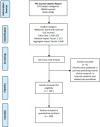Citation classics in general medical journals: assessing the quality of evidence; a systematic review
- PMID: 32308931
- PMCID: PMC7149815
Citation classics in general medical journals: assessing the quality of evidence; a systematic review
Abstract
Aim: This review provides a comprehensive overview of more than 100 of the most cited studies in general medical journals and evaluates whether citations predict the quality of a scientific article.
Background: The number of citations is commonly used as a measure of the quality and impact of a scientific article. However, it is often criticised that the number of citations is in fact a poor indicator of the true quality, as it can be influenced by different factors such as current trends.
Methods: This review was conducted in line with the PRISMA guidelines. The Journal Citation Report (JCR) within Incites allowed the evaluation and comparison of articles, published in general medical journals, using far-reaching citation data drawn from scholarly and technical journals and conference proceedings. All steps of the review were performed in duplicate and conflicts were resolved through consensus.
Results: The 100 most cited articles published from 1963 until the end of 2018 were identified. The number of citations ranged from 4012 to 31853. Most of the articles were published in the 2000's, followed by the 1990's, 1980's, 1970's and 1960's, respectively. All of the articles were published in five journals. There were 50 studies at level II, 28 at level V, 10 at level IV, 7 at level III, and 5 at Level I.
Conclusion: This systematic review provides an overview of the most cited articles, published in general medical journals. The number of citations provides an indication of the quality of evidence. However, researchers and clinicians should use standardized assessment tools rather than solely rely on the number of citations in order to judge the quality of published articles.
Keywords: Article quality; Bibliometrics; Citation classics; General medical journals; Level of evidence; Most-cited articles.
©2020 RIGLD, Research Institute for Gastroenterology and Liver Diseases.
Figures







References
-
- Guyatt GH. Evidence-based medicine. ACP J Club. 1991;114 - PubMed
-
- Sackett DL. Rules of evidence and clinical recommendations on the use of antithrombotic agents. Chest. 1989;95:2–4. - PubMed
-
- Ahmad SS, Ahmad SS, Kohl S, Ahmad S, Ahmed AR. The hundred most cited articles in bariatric surgery. Obes Surg. 2015;25:900–9. - PubMed
Publication types
LinkOut - more resources
Full Text Sources
